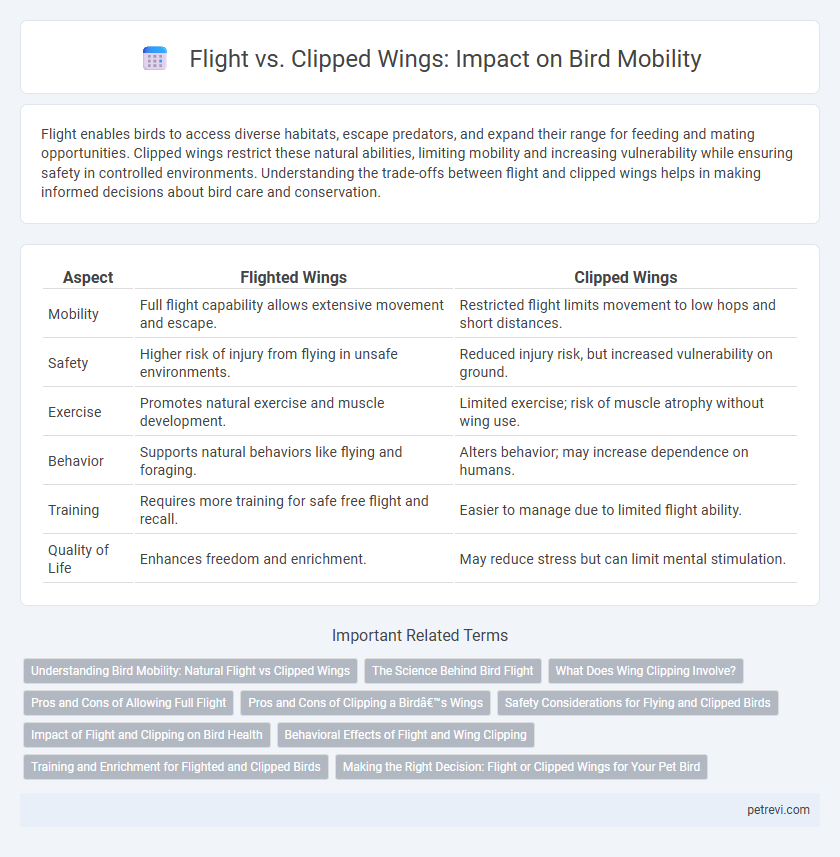Flight enables birds to access diverse habitats, escape predators, and expand their range for feeding and mating opportunities. Clipped wings restrict these natural abilities, limiting mobility and increasing vulnerability while ensuring safety in controlled environments. Understanding the trade-offs between flight and clipped wings helps in making informed decisions about bird care and conservation.
Table of Comparison
| Aspect | Flighted Wings | Clipped Wings |
|---|---|---|
| Mobility | Full flight capability allows extensive movement and escape. | Restricted flight limits movement to low hops and short distances. |
| Safety | Higher risk of injury from flying in unsafe environments. | Reduced injury risk, but increased vulnerability on ground. |
| Exercise | Promotes natural exercise and muscle development. | Limited exercise; risk of muscle atrophy without wing use. |
| Behavior | Supports natural behaviors like flying and foraging. | Alters behavior; may increase dependence on humans. |
| Training | Requires more training for safe free flight and recall. | Easier to manage due to limited flight ability. |
| Quality of Life | Enhances freedom and enrichment. | May reduce stress but can limit mental stimulation. |
Understanding Bird Mobility: Natural Flight vs Clipped Wings
Natural flight provides birds with essential benefits including efficient foraging, migration capability, and predator evasion, all crucial for survival and ecosystem balance. Clipped wings significantly reduce a bird's ability to fly, limiting mobility and increasing dependency on human care, which can affect physical health and mental stimulation. Understanding these differences is vital for ethical bird care, emphasizing the importance of preserving natural flight for optimal bird well-being and behavior.
The Science Behind Bird Flight
Bird flight relies on the intricate interplay of wing structure, muscle strength, and aerodynamic principles that generate lift and thrust for efficient mobility. Clipped wings, involving the trimming of primary feathers, disrupt the balance of these components, significantly reducing lift and restricting flight capability. Scientific studies show that wing clipping alters airflow patterns and muscle engagement, directly impeding a bird's natural flight mechanics and overall mobility.
What Does Wing Clipping Involve?
Wing clipping involves trimming a bird's primary flight feathers to limit its ability to fly while maintaining balance and mobility. This procedure reduces lift and prevents long flights, helping to manage safety and control indoor or outdoor bird movement. Proper wing clipping must be done carefully to avoid injury and discomfort, typically performed by a professional or experienced bird owner.
Pros and Cons of Allowing Full Flight
Allowing full flight in birds enhances natural mobility, enabling access to diverse habitats, escape from predators, and improved foraging opportunities critical for survival and well-being. However, unrestricted flight may increase the risk of injury or loss, particularly in urban or indoor settings where birds can collide with windows or become trapped. Balancing natural flight with controlled environments is essential to maximize the bird's physical health and psychological enrichment while minimizing hazards.
Pros and Cons of Clipping a Bird’s Wings
Clipping a bird's wings restricts its ability to fly, reducing the risk of injury or escape while enabling safer indoor mobility and easier handling by owners. However, wing clipping can limit natural behaviors, decrease exercise, and potentially lead to stress or muscle atrophy if not managed properly. Careful assessment of species, lifestyle, and individual bird needs is essential to balance safety with maintaining optimal physical health and quality of life.
Safety Considerations for Flying and Clipped Birds
Flight provides birds with natural escape mechanisms from predators and access to diverse habitats, enhancing their survival and overall safety. Clipped wings reduce mobility, increasing vulnerability to household hazards such as windows, ceilings, and other pets. Ensuring a secure environment with bird-safe cages and monitoring is critical in maintaining the safety of clipped birds.
Impact of Flight and Clipping on Bird Health
Flight enables birds to maintain muscular strength, regulate body temperature, and enhance cardiovascular health through consistent exercise. Clipped wings restrict these natural activities, often leading to muscle atrophy, increased stress, and higher susceptibility to obesity and related metabolic disorders. Limiting flight compromises a bird's mental stimulation and overall well-being, which can result in behavioral issues and weakened immune function.
Behavioral Effects of Flight and Wing Clipping
Flight enables birds to engage in natural behaviors such as foraging, mating displays, and territorial defense, promoting mental stimulation and physical health. Wing clipping restricts mobility, often leading to decreased activity, increased stress, and altered social interactions, which can negatively impact overall well-being. Understanding these behavioral effects is essential for bird owners and conservationists to ensure appropriate care and habitat management.
Training and Enrichment for Flighted and Clipped Birds
Flighted birds benefit from training that enhances natural behaviors like flying, foraging, and navigating diverse environments, promoting mental stimulation and physical fitness. Clipped birds require tailored enrichment strategies, such as interactive toys and ground-based activities, to compensate for limited mobility and prevent boredom. Both approaches emphasize safety and well-being, ensuring birds maintain optimal health regardless of wing status.
Making the Right Decision: Flight or Clipped Wings for Your Pet Bird
Choosing between allowing your pet bird to fly freely or opting for clipped wings involves assessing safety, mobility, and well-being. Flight supports natural behaviors and exercise but increases risks of injury or escape, while clipped wings limit mobility to enhance control and safety indoors. Evaluating your bird's environment, species-specific flight capabilities, and your ability to supervise helps determine the optimal choice for maintaining a healthy and secure pet.
Flight vs Clipped Wings for Bird Mobility Infographic

 petrevi.com
petrevi.com